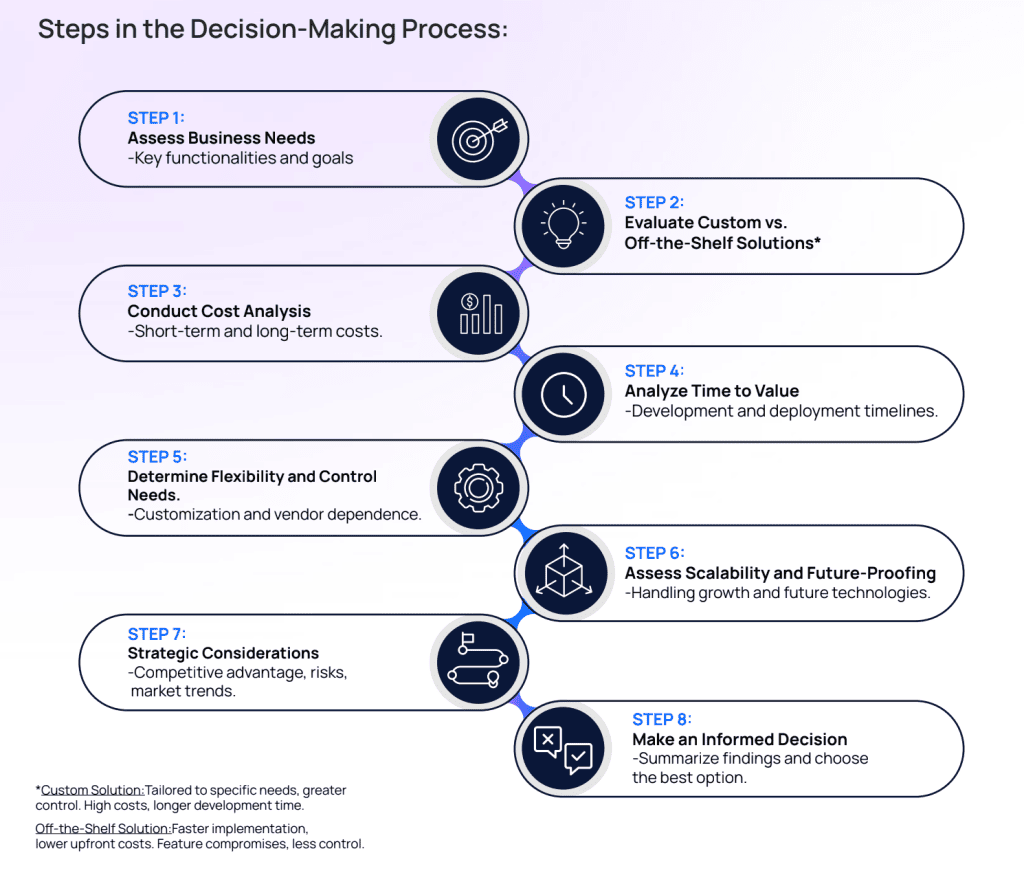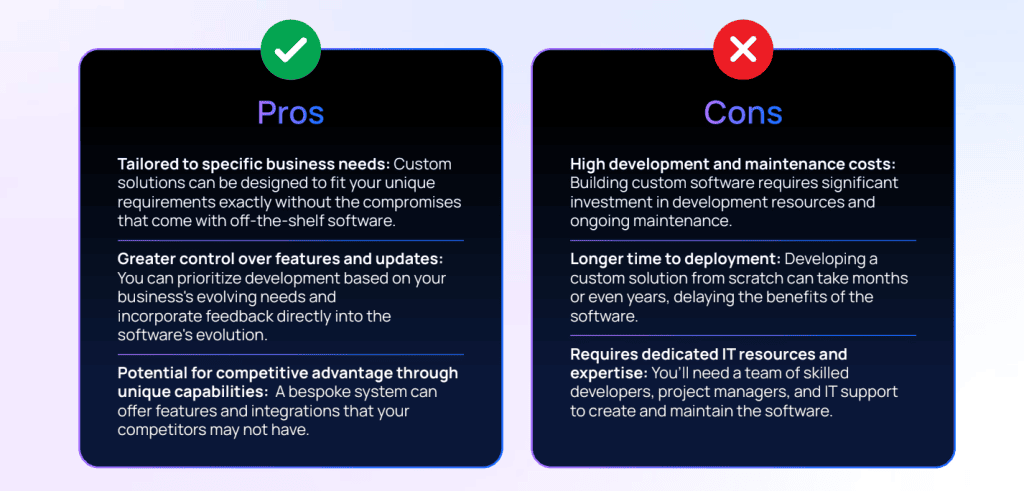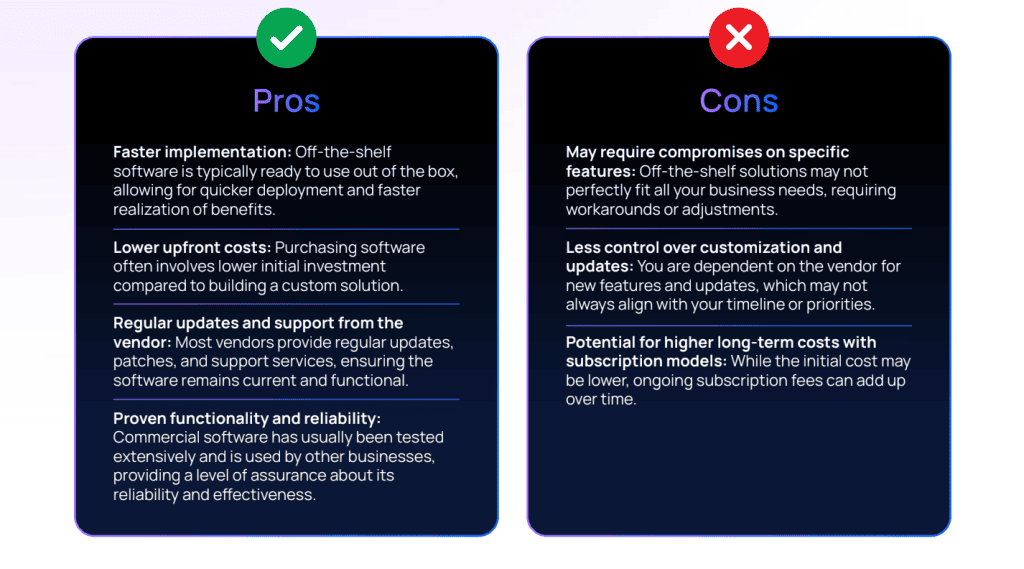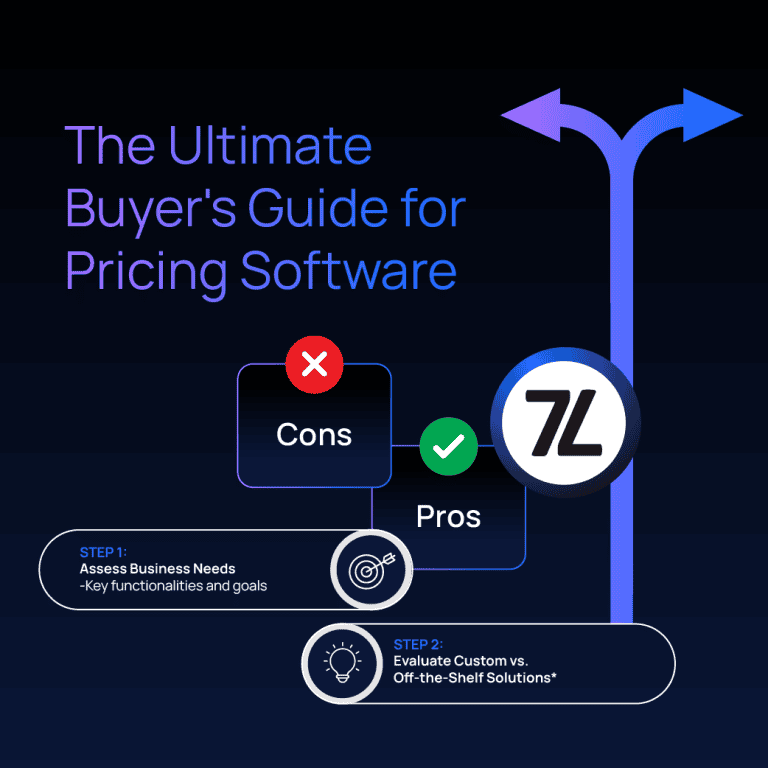Pricing software enhances and streamlines one of the most critical aspects for the majority of B2C and B2B businesses and is, therefore, a crucial component in the strategic makeup. With the right pricing tool, analyzing data, formulating predictions, and executing pricing tasks can be carried out with greater speed and precision than ever before, especially when compared with purely manual workflows. As such, the process of selecting the right pricing software for your business is of critical importance.
It has been proven that a 1% improvement in pricing drives 6% more profit, however, achieving this improvement is not always straightforward. In the past 12 – 18 months, 58% of companies have expressed regret over a software purchasing decision, which can often have costly consequences. This need not be the case – by investing adequate time and resources into the buying process, the chances of buyer’s remorse (and lost profit) are significantly reduced.
As experts in predictive pricing software, we at 7Learnings have helped leading businesses boost their performance by analyzing and optimizing their pricing and marketing strategies. With the knowledge we have gained through our work in the industry, we have compiled this comprehensive guide featuring everything you need to know to evaluate and select the right pricing software for your needs.
Download the Pricing Software Buyer's Guide in PDF format

Understand the capabilities to look for in pricing software providers
Choosing the right pricing software begins with understanding the essential capabilities to look for. New technologies like AI and Machine Learning, along with the availability of vast amounts of data, have significantly changed how retailers approach pricing today. Retailers should invest time in educating themselves about these technologies and how they are used, as selecting the right pricing solution is often as much a technology decision as it is a business one.
Learning about these new possibilities can reshape their view of requirements and influence the vendor selection process. It’s crucial for retailers to fully understand their problem and explore different ways of solving it before defining their specific software requirements.
Common features to look out for in pricing software include:
- Dynamic pricing: The ability to adjust prices based on market demand, competition, and other external factors in near real-time. This feature helps you stay competitive and optimize revenue.
- Integration: Seamless integration with existing ERP, CRM, and other business systems ensures that the pricing software works well within your current technological ecosystem. This reduces redundancy and increases efficiency.
- User-friendly interface: An intuitive interface that is easy to navigate and use for all team members, including those who may not be tech-savvy. A well-designed UI can reduce training time and increase user adoption rates.
- Scalability: The software should grow with your business, handling increasing volumes of data and transactions. Scalability ensures that you won’t outgrow the software as your business expands.
- Customizability: Ability to tailor the software to your specific industry needs and business processes. Customizability allows you to address unique business challenges and capitalize on opportunities.
- Reporting and analytics: Comprehensive reporting tools to analyze pricing performance and make data-driven decisions. Robust analytics can provide insights into customer behavior, market trends, and profitability.
- Security: Robust security features to protect sensitive pricing data. This includes encryption, access controls, and compliance with relevant regulations (e.g., GDPR, CCPA).
- AI and machine learning: Utilization of advanced algorithms to predict optimal pricing strategies and uncover insights from data. AI-driven software can identify patterns and trends that are not immediately obvious, providing a strategic edge.
- Many pricing providers purport to use AI, when actually they have just implemented some basic algorithms. To ensure your pricing provider is really using AI, follow the steps outlined in our blog: “Is your pricing provider really using AI?”
By focusing on these capabilities, you ensure the software you choose will meet your current and future needs.
Build vs buy for pricing software
Once you have an understanding of the capabilities required, a question that often comes up is whether to purchase a third-party solution or build in-house. When deciding between building a custom solution or buying an off-the-shelf product, consider the following:
Building custom pricing software

Buying off-the-shelf pricing software

There are several mature off-the-shelf pricing solutions for the retail market. The main reason to build custom pricing software is to gain a competitive advantage, but there is also substantial effort and risk involved in developing a custom solution which must be considered – failures can be extremely costly.
We recommend making this strategic decision with caution and critically evaluating whether a custom solution will actually lead to a significant competitive advantage. Evaluate your business needs, budget, and available resources to determine the best approach for your organization.
Align with your business requirements
The next step following a decision to buy, before diving into vendor research, is to clearly define your business requirements. Consider the following aspects:
- Business goals: What are the primary objectives you aim to achieve with the pricing software? (e.g., increase margins, improve pricing accuracy, respond faster to market changes) Clearly defined goals will guide your decision-making process and help you measure the software’s success.
- Budget: Determine your budget for both initial implementation and ongoing costs. Consider not only the software purchase price but also any additional costs such as training, support, and future upgrades.
- User needs: Identify who will be using the software and their specific needs (e.g.pricing analysts, finance). Involve representatives from these groups in the selection process to ensure the software meets their requirements.
- Integration needs: Ensure the software can integrate seamlessly with your existing systems, such as ERP, CRM, and other relevant tools. This integration is crucial for maintaining data consistency and optimizing workflows.
- Industry specifics: Consider any industry-specific requirements or regulations that the software needs to comply with. For example, certain industries may have specific pricing models, regulatory constraints, or competitive dynamics that need to be addressed.
By having a clear understanding of your requirements, you can narrow down your options and focus on solutions that best fit your business.
Conduct pricing software vendor research
To ensure you meet your business requirements, thorough vendor research is crucial in finding the right pricing software. Start with:
- Peer recommendations: Seek recommendations from industry peers or business networks. Colleagues who have implemented pricing software can provide firsthand insights into their experiences and the software’s performance.
- Online reviews: Read reviews and ratings on software comparison websites like G2, Capterra, and TrustRadius. These platforms offer user-generated reviews that can highlight both the strengths and weaknesses of different solutions.
- Industry reports: Look at analyst reports and market studies for reputable vendors in the pricing software space. Reports from firms like Gartner, Forrester, and IDC can provide valuable insights into vendor capabilities and market trends.
- Vendor websites: Visit vendor websites to understand their offerings and capabilities. Pay attention to case studies, whitepapers, and customer testimonials that can provide additional context and validation of the software’s effectiveness.
Create a list of potential vendors and gather as much information as possible to evaluate their suitability for your business needs.
Ensure you have stakeholder buy-in
Your decisions must have approval from those it will affect, as such, securing stakeholder buy-in is critical for a successful software implementation. Engage key stakeholders early in the process, including:
- Executive team: Ensure the executive team understands the strategic value of the pricing software and its alignment with business goals. Highlight how the software can drive revenue growth, improve efficiency, and provide a competitive edge.
- IT department: Involve IT in assessing technical feasibility and integration requirements. The IT team can evaluate the software’s compatibility with existing systems, infrastructure needs, and security implications.
- End users: Engage end users to gather their input and address their needs and concerns. Conducting user surveys or focus groups can help identify specific requirements and potential challenges from the perspective of those who will be using the software daily.
- Finance team: Work with finance to understand budget constraints and ROI expectations. The finance team can help develop a cost-benefit analysis and ensure the investment aligns with overall financial objectives.
By involving stakeholders from the beginning, you can build a consensus and ensure a smoother implementation process.
Compile your Request for Proposal (RFP)
Once you have a shortlist of potential vendors, compile a comprehensive Request for Proposal (RFP). Your RFP should include:
- Company overview: Provide an overview of your company and industry, highlighting key aspects that are relevant to the software implementation.
- Project objectives: Clearly define the objectives and goals of the pricing software implementation. Describe what you hope to achieve and how you will measure success.
- Detailed requirements: Outline your specific requirements, including features, integration, security, and support. Be as detailed as possible to ensure vendors understand your needs.
- Use cases: Define specific use cases that demonstrate how you intend to use the software in your business operations. These scenarios will help vendors understand your practical needs and how their software can address them. Use cases can include examples like dynamic pricing adjustments, integration with existing ERP systems, or handling seasonal pricing strategies.
- Evaluation criteria: Specify the criteria you will use to evaluate proposals. This is especially important for AI solutions, as they not only enable decisions but also recommend them. You should think carefully about how to evaluate the solutions’ effectiveness. There are two suggested methods:
- Timeline: Provide a timeline for the RFP process, including deadlines for submission and selection. Outline the key milestones and decision points in the evaluation process.
An effective RFP helps vendors understand your needs and provides a basis for a fair comparison of their offerings.
Create a shortlist of vendors
Based on the responses to your RFP, create a shortlist of vendors that best meet your requirements. Evaluate them based on:
- Capabilities: Ensure the software meets all your critical requirements and offers the features necessary to achieve your business goals.
- References: Check customer references to verify the vendor’s track record. Speak with current and past customers to understand their experiences with the software and the vendor.
- Cost: Compare pricing models and total cost of ownership. Consider both the initial costs and the long-term expenses associated with each solution.
- Support: Assess the quality and availability of vendor support. Reliable support is crucial for addressing issues quickly and minimizing downtime.
Narrowing down your options to a manageable list allows for a more in-depth evaluation.
Request presentations & ask questions
Invite the shortlisted vendors to present their solutions. During these presentations:
- Ask detailed questions: Probe into how the software addresses your specific needs and any potential limitations. Questions might include how the software handles specific pricing scenarios, how it integrates with your current systems, and what customization options are available.
- Request demos: See the software in action to understand its user interface and functionality. Hands-on demonstrations can provide a better sense of how the software will perform in real-world conditions.
- Evaluate integration: Discuss how the software will integrate with your existing systems. Ask for examples of similar integrations the vendor has completed successfully.
- Assess vendor expertise: Evaluate the vendor’s industry knowledge and expertise. A vendor with deep industry experience is more likely to understand your unique challenges and offer relevant solutions.
Presentations provide an opportunity to see the software firsthand and assess the vendor’s ability to deliver on their promises.
Contact customer references
Speaking with current customers of the shortlisted vendors can provide valuable insights. Ask customer references about:
- Implementation experience: How was the implementation process? Were there any challenges, and how were they addressed? Understanding the implementation process can help you anticipate potential issues and plan accordingly.
- Software performance: How well does the software perform in a real-world environment? Inquire about any issues with reliability, speed, and user satisfaction.
- Support quality: How responsive and helpful is the vendor’s support team? Good support can make a significant difference in resolving issues quickly and maintaining smooth operations.
- ROI: Has the software delivered the expected return on investment? Ask about tangible benefits such as increased revenue, cost savings, and improved efficiency.
Customer references can confirm the vendor’s claims and give you confidence in your decision.
Selecting your preferred vendor
After thorough evaluation, you need to choose the method to finalize your decision on the preferred vendor for AI-based pricing solutions. There are two main approaches: the Tournament method and the MVP with one vendor method.
Tournament
In the Tournament approach, you conduct a competitive evaluation where multiple vendors are tested simultaneously under the same conditions. This approach involves several key steps:
- Simultaneous testing: Evaluate multiple vendors’ solutions at the same time using a standardized set of criteria. This might involve running an AB test with a control group and several groups priced with different pricing solutions.
- Clear evaluation metrics: Define specific, measurable criteria to assess the effectiveness of each solution. Criteria may include accuracy of AI recommendations, ease of integration, user experience, scalability, and overall performance.
- Controlled environment: Ensure all vendors operate under the same conditions to provide a fair comparison. Use a consistent dataset and standardized testing scenarios to evaluate each solution’s capabilities.
- Comprehensive analysis: Gather feedback from all relevant stakeholders, including end-users and technical teams. Analyze the performance data to determine which solution best meets your business needs.
The Tournament method allows you to compare vendors directly and objectively, providing a clear view of each solution’s strengths and weaknesses. This approach is highly recommended if it is technically feasible, as it reduces bias and ensures a data-driven decision-making process.
MVP with one vendor
If the Tournament method is not feasible, you can opt for the MVP with one vendor approach. This involves selecting a single vendor to implement a Minimum Viable Product (MVP) and evaluate their solution in a limited scope. The steps include:
- Vendor selection: Choose a vendor based on initial evaluations, such as responses to your RFP, vendor presentations, and reference checks.
- Define MVP scope: Clearly outline the scope of the MVP, including specific use cases, objectives, and success criteria. Focus on critical features and functionalities that will provide the most insight into the solution’s capabilities.
- Implementation and testing: Work closely with the selected vendor to implement the MVP. Conduct thorough testing and gather feedback from end-users and technical teams.
- Evaluation: Assess the MVP’s performance against the defined success criteria. Evaluate the solution’s effectiveness, ease of use, and integration capabilities.
While the MVP approach provides a detailed evaluation of one solution, it lacks the direct comparative insights offered by the Tournament method. However, it allows for an in-depth understanding of a single vendor’s capabilities and can be a practical alternative if resources or technical constraints limit a multi-vendor evaluation.
Conducting a Proof of Concept (PoC)
Before finalizing your decision, conduct a Proof of Concept to validate the software’s capabilities in your environment. This involves:
- Defining objectives: Clearly outline what you aim to achieve with the PoC. This could include testing specific features, evaluating integration capabilities, or assessing performance under load.
- Setting success criteria: Establish measurable criteria to determine if the PoC is successful. These criteria should align with your business goals and requirements.
- Limited scope: Run the PoC on a smaller scale to manage resources and focus on critical areas. This could involve using a subset of your data or running the software in a controlled environment.
- Evaluation: Assess the results of the PoC against the success criteria. Gather feedback from end users and technical staff to understand their experiences and any challenges encountered.
- Decision making: Use the insights gained from the PoC to make an informed decision. If the PoC meets your objectives and criteria, it provides strong validation for moving forward with the vendor.
Final decision
After conducting either a Tournament or an MVP with one vendor, make your final decision based on the evaluation results. Consider:
- Overall fit: Ensure the chosen solution aligns with your business requirements and goals. It should meet your critical needs and have the flexibility to adapt to future changes.
- Vendor reliability: Confirm the vendor’s reputation and financial stability. A reliable vendor is crucial for long-term support and updates.
- Future scalability: Ensure the software can scale with your business growth. It should handle increased data volume, users, and transactions as your business expands.
Choosing the right vendor sets the foundation for a successful pricing software implementation. Conducting a thorough evaluation, whether through a Tournament or an MVP, ensures that you make an informed decision based on solid evidence and clear criteria.
Negotiate and sign agreements
Once you’ve selected your preferred vendor, negotiate the terms of the agreement. Key points to consider:
- Pricing: Ensure the pricing model aligns with your budget and includes all necessary features and support. Be clear about any additional costs, such as training, implementation, and future upgrades.
- Service Level Agreements (SLAs): Define the expected levels of service and support. SLAs should outline response times, resolution times, and penalties for non-compliance.
- Implementation plan: Agree on a detailed implementation plan with clear timelines and milestones. The plan should include roles and responsibilities, key deliverables, and a schedule for training and onboarding.
- Exit clauses: Ensure there are clear exit clauses in case the software does not meet expectations. Define the terms for terminating the agreement and any associated costs.
A well-negotiated agreement protects your interests and sets clear expectations for both parties.
Schedule regular check-ins and an implementation timeline
Successful implementation requires careful planning and regular check-ins. Develop a detailed implementation timeline with the vendor, including:
- Kickoff meeting: Start with a kickoff meeting to align on goals and expectations. Use this meeting to introduce key stakeholders, outline the implementation plan, and establish communication protocols.
- Milestones: Define key milestones and deliverables throughout the implementation process. Regularly review progress against these milestones to ensure the project stays on track.
- Training: Schedule training sessions for end users to ensure they are comfortable with the new software. Training should be comprehensive and include follow-up sessions as needed.
- Regular check-ins: Hold regular check-in meetings to monitor progress, address issues, and make adjustments as needed. These meetings provide an opportunity to discuss any challenges, review progress, and ensure alignment with project goals.
By maintaining open communication and monitoring progress, you can ensure a smooth implementation and maximize the benefits of your new pricing software.
Choosing the right pricing software is a critical decision that can drive significant value for your business. By following this comprehensive guide, you can navigate the process with confidence and select a solution that aligns with your business goals and requirements.




